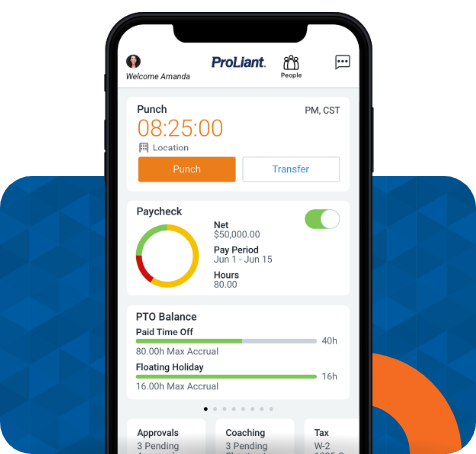Many business owners choose to process payroll independently, and many use outdated practices and paper filing methods which can lead to inaccuracies and penalties. Online payroll service providers are worth the investment because they streamline payroll and other complex HR processes and remove worries and headaches when it comes to taxes.
This article will review the steps for processing payroll and the tools needed to ensure accuracy and compliance.
Step 1: Gather Essential Payroll and Tax Information
Before you begin processing payroll, it is necessary to gather all essential information.
Employer Identification Number (EIN). This number is required for reporting taxes and submitting documents to the IRS. You will also need this number to report employee information to state agencies. Apply for an EIN online or contact the IRS directly.
State/Local IDs. Some state or local governments require businesses to obtain Tax Identification Numbers to process taxes.
Employee paperwork (see below). Employee paperwork will include demographic and tax information.
Independent Contractor or Employee. It is essential to check that the difference between an employee and an independent contractor is clear, which can be challenging to discern.
Check out our recent blog article about recent developments about the difference between employee and independent contractor classifications: Read about it here.
Payroll Schedule. Some states have laws that determine pay periods, mostly favoring bi-monthly payments. There are a few different pay schedule options, and certain types of employees may be on different pay schedules.
Proliant’s online payroll services makes it easy to calculate payroll for employees on various pay schedules, even if they are working in many different states.
Employee Information and Paperwork
There is a lot of employee demographic and tax information that is needed to get started with processing payroll. Here is what you’ll need from your employees:
- Completed job application
- W-4
- Application for state withholding certificates
- I-9
- Bank information for direct deposit
- Medical insurance forms if applicable
- Retirement plan documents if you are offering retirement and 401(k)
- Union contracts and other documentation
- Contracts, non-competes, intellectual property
- Signatures for employee handbook and policies
Proliant’s online payroll services help by integrating with your existing systems so that the data you already have in your HR or applicant tracking and recruitment tools is easily transferred over and organized in a safe virtual space.
Step 2: Pay Employees
To pay employees, you must begin by reviewing and documenting employee compensation terms. You must take into consideration how some aspects of employee pay will be calculated, including:
- Total hours worked
- Overtime
- Paid time off
You will also need to factor in deductibles such as health plan premiums and retirement contributions which will need to be deducted from employee paychecks and paid to those organizations.
Wage Garnishments
A wage garnishment refers to when a portion of an employees earnings are required by law or other equitable procedure to be withheld for the payment of a debt.
If it is necessary for you to garner an employee’s wages, you will receive the information you need to know about how to calculate the amount you have to garnish and where to send the money. This information comes in the form of a “wage garnishment package.”
Almost all forms of employee earnings are considered compensation for wage garnishments, including wages, salaries, commissions, bonuses, and pension and retirement plan payments. Tips are not usually considered earnings when it comes to wage garnishments.
Learn more about wage garnishments here.
Ways to Pay Employees
Most businesses pay employees with printed paychecks or by direct deposit based on a determined pay schedule (usually twice monthly or every two weeks). However, employees may also be given early access to their earned wages through on-demand pay services. These services typically provide employees with pay cards and have the added benefit of providing greater financial security for employees who work part-time and live paycheck to paycheck.
Learn more about on-demand pay here.
Learn about Proliant’s versatile solution for on-demand pay ReadyPay Today.
Step 3: Keep records
There are many federal and state laws requiring employers to keep and maintain records for certain periods of time, including:
- W-4 forms (indicating employee tax withholding status)
- W-2s
- Copies of filed tax forms
- Dates and amounts of all tax deposits
Maintaining all of these records can become very tedious to keep track of without the necessary technology, especially as your business grows. Online payroll and tax services, like those offered by Proliant, are valuable tools to ensure all records are maintained and up-to-date.
Step 4: Report Payroll Taxes
There are many payroll tax reports that employers are required to submit quarterly or annually. State tax agencies will have information for specific tax filing requirements. Here are a few of the main things to keep track of when it comes to business taxes:
- Tax deadlines
- Forms, schedules, and election statements
- Estimated tax
- Deductions
- Tracking expenses
- Tax updates and developments
- Federal vs. state taxes
- Retirement plans and expenses
There are many mistakes business owners can make when filing and reporting taxes. Here are some tips for things to look out for and how to ensure you get things right the first time: Read more.
Outsourcing Payroll for Your Business
Unlike large companies, smaller businesses don’t always have the staffing and capabilities necessary to handle payroll or other core HR functions. Outsourcing payroll and other functions to Proliant ensures compliance and accuracy and allows business owners to focus on growing and managing their businesses.
At Proliant, we provide the tools and expert knowledge for processing accurate and timely payrolls. We also take care of the following:
- Take over power of attorney if needed
- Communicate with IRS on behalf of our clients
- Provide a dedicated representative for tax questions and resolutions
- Make updates as rules and regulations change
- Ensure business gets all tax deductions available
To learn more about how Proliant can help with your payroll needs, request a meeting today.







No Comments Yet
Let us know what you think